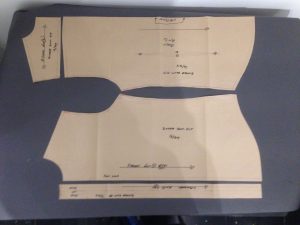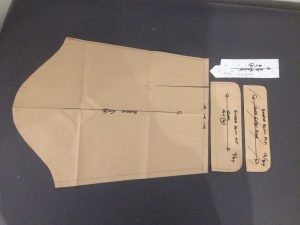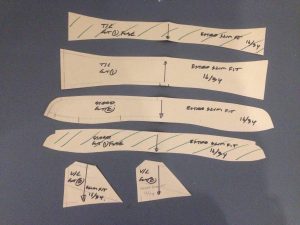Mans Shirt Draft
The Basic Shirt Draft.
13/22). If you have ever tried to draft a man’s shirt pattern block you will almost certainly have found that your pattern didn’t turn out quite as expected, even if you followed the draft formula exactly.
Unless you are a very experienced bespoke shirt maker, drafting a pattern from a shirt cutting formula is not the way to create the best shirt block.
While some bespoke shirt makers may draft their patterns from scratch, because they are dealing with so many different shapes and sizes, most commercial pattern makers do not.
Instead, they will adapt previously perfected patterns or blocks that are closest to the new style they want to create. Or they will use a good tried and tested reference garment.
If they are creating a shirt pattern for the first time and have no previous patterns to use, then they will normally find a good reference garment to copy and adapt for their custom design.
Shirt Pattern Cutting Class.
We run a one-to-one or paired shirt pattern cutting class from our studio in Walthamstow London. Please email for more information.
Why Drafts Dont Work .
For some reason people are convinced that in order to make a good shirt pattern they have to draft the shape from a formula. But most shirt block drafts are over complicated and counter intuitive.
It takes years to perfect drafting patterns, even for professionals. It is easy to make a mistake in drafting, and the draft you use may not be for the type of shape that you really want anyway.
If you are unfamiliar with how a shirt pattern should look and how one pattern piece should connect to another you will have no idea what a good pattern should look like. And you will not know how to adjust the shapes and the curves correctly.
When you have finished your draft it is essential to check that each pattern piece joins to the other pieces in flowing lines or curves.
A sharp angle at the side neck point will throw your collar out dramatically, and you will think that it is the collar that is wrong.
But even if you have drafted your shirt pattern perfectly, and ensured that it all fits together, with all the curves running smoothly, your pattern is just a generic shape, not made for your individual requirements.
Although the pattern may have been created using your bespoke measurements, with the best shirt draft formula, the design and fit are still just generic. You may want more or less ease, or a higher or lower armscye.
Different Shapes.
There are many different types of shapes and fits for a man’s shirt. Each one needs its own block from which you can create custom designs.
Some shirts are a loose fit, while others are a tight fit. Some have waist darts to add a little shaping. Others may have a side body to give a very tailored fit.
Most traditional shirts will have a back yoke with a little shaping for the shoulder blade. The yoke generally extends about 4cms forward of the natural shoulder line.
The addition of back shoulder pleats allow for some forward arm movement.
You can’t use a loose fitting shirt block to create a fitted style, and vice versa, although the collars, cuffs, collars, and plackets should still be generally interchangeable.
Once you have a basic block you can usually mix and match a variety of collars, cuffs, front plackets, and pockets. It is a good idea to keep a selection of tried and tested shapes to use for different shirts.
Drafting your basic shirt pattern is only a small part of making a complete man’s shirt pattern.
Our basic mans shirt draft does not include seams, but once completed it is advisable to add seam allowances for your finished block.
We try to make the draft itself as simple and self explanatory as possible, based on a basic mans body block, using a good mens shirt cutting.
What Are Different Types Of Shirt Shapes ?
There are many different types of shirt fits today. Sometimes different names are given for the same fit, or the types of fit may cross over :
- Classic Fit
- Slim Fit
- Regular Fit
- Tailor Fit
- Muscle Fit
- Skinny Fit
- Athletic Fit
- Tapered Fit
Copy A Garment.
Professional pattern makers rarely need to draft new blocks. They are constantly adapting existing patterns or blocks for each new style. Each season may require a slightly different shape.
Using a shirt draft is not always the best way to create the shape you want. The only times that I created a block from a draft was at the very beginning of my career as a pattern cutter. I soon discovered that it was not straight forward.
The better way if you have no existing pattern, is usually to copy an existing shirt made by a reputable brand. This way you know that a lot of time and expertise has gone into perfecting that specific shirt shape.
Find a good shirt that you like, and adapt it in any way that you like. You can change the length of the body, or sleeve. You can of course use a different cuff or collar shape.
A good shirt pattern cutter knows exactly how to adapt their own blocks to use with an existing garment to ensure good balance and shape.
Drafts used absent of extensive knowledge have a habit of not always quite working out without significant adjustments.
Using an existing shirt ensures that your final pattern is exactly the shape you want it to be, as long as you copy it correctly. A reputable shirt manufacturer use pattern shapes perfected over many years.
It is best to copy a check or stripe patterned shirt so that you have a convenient grid to work from. A plain shirt will do, but is not ideal, and is open to errors.
The most difficult part of a shirt to get right is the collar. Each collar pattern should be drafted for the specific neck shape it is to fit. Some may draft a collar so that the neck will stetch onto the collar a little.
A formal shirt collar is far more complicated than a casual collar, because it has a lot going on internally, which involves some knowledge about shirt collar construction.
Learn How To Draft A Shirt Block.
The London Pattern Cutter runs a number of pattern cutting classes from several locations in London. Most of our classes are one-to-one classes, custom made to your own requirements.
We run a mans shirt block workshop for a small group. Please contact us for further details. Gents shirt cutting formula.
History Of Shirts.
Shirts have been around since before the middle ages, having originated as under garments and night gowns. In the earlier days these shirts were generally very simple, home made garments that were just pulled over the head, without buttoned openings.
The better off however, would have their shirts tailor made. Like all menswear, the design of the shirt changed only very slowly over the years.
The modern day shirt began really with the button front shirt, first registered by Brown,Davies & Co. in 1871. In the 1930`s the fixed collar shirt gained in popularity and has remained popular ever since.
EMAIL
Formal Shirt Pattern.
While a plain casual shirt is relatively straight forward, a formal shirt is far more complicated and, like most Menswear, requires a very precise pattern and a good specialist factory to make it.
Specialist shirt factories are very few and far between in the U.K. They can be found, but special care must be taken to ensure the production is of a high quality.
It is easier to find overseas production for formal shirts, but they would normally require higher quantities and extra special care would need to be taken to make sure of the quality of production.
We have worked for a number of medium sized formal shirt manufacturers who use offshore factories. For them it makes total sense, because it is far cheaper than using U.K. production.
If they find a good factory, then this is a great alternative. But DONT use them to make patterns. They do not usually understand patterns or aesthetics. And they do not usually use professional pattern cutters and graders. We would also suggest having your own sample made before approaching a factory.
Factory Made Patterns.
Many shirt companies will get the factory to provide the patterns and grading from a measurement spec. We do not have a problem with the factory providing the grading as long as you give them a carefully thought out size spec to follow.
If you give them a set of measurements to follow for the initial pattern however, the garments may well turn out exactly to spec, but the shaping may all be in the wrong place.
For example,If you ask them to make three different fits – slim, tailored and regular – and you supply three different armhole measurements, they will often just add the extra allowance at the shoulder rather than the armhole depth or width.
This means that the shoulder area is very baggy and mis-shapen, while the armhole is too high. All the measurements are to spec. But the shape is in the wrong place.
Sample.
It is very important that anyone who wants a professional looking shirt has the patterns made by proper pattern cutters who understand shirts and understand fit and style. We would suggest employing an experienced shirt pattern cutter to make the base pattern, along with a toile or sample.
Once you are happy with the shape, then get the factory to make their own sample. When you are happy with that, then supply them with a good size spec. using their sample as the starting point. It has to be their sample because the way they make it may affect the measurements.
Shirt Style.
When you buy a shirt from a big brand usually you are aware of the type of fit and styling that you are getting. A Charles Tyrwhitt shirt will give you one type of style with several types of it fit.
An M&S shirt will be another type of style and a Zara shirt another. All these shirts will always look good in their own way, because a lot of work and hours have been put in by professional people to ensure that it is perfect.
When you buy a designer shirt this is not always the case, because many designers do not employ good specialist pattern cutters. Instead they rely on their designer reputation and the design itself. A well known designer can get away with this, but an emerging designer cannot do so easily.
Top Quality.
A lot of time goes into making a mans shirt pattern as there are many different pieces that need to be made very precisely in order to achieve a top quality look.
The collar particularly needs to be made with the correct fusing quality and shape, otherwise the collar will not look crisp and will not fold correctly. A good collar is absolutely vital to a mans shirt.
We have been making top quality mens shirt patterns and samples as well as made to measure bespoke shirts for individual clients for forty years.
Factory Ready Patterns.
All the shirt patterns we provide are complete patterns ready for the factory with all necessary fusing pieces, instructions, markings and notches.
The Classic shirt patterns are made with traditional flat felled seams as well as collar stay pieces for dress shirts. If you require more information along with prices, please feel free to contact me. Basic styles include :
- Dress Shirt – Classic fit – Centre back pleats.
- Dress Shirt – Classic fit – Centre back pleats – French cuffs.
- Dress Shirt – Classic fit – Side back pleats.
- Dress Shirt – Slim fit – No back pleats.
- Dress Shirt – Super slim fit – No back pleats.
- Sports Shirt – Standard fit – Centre back pleats.
- Sports Shirt – Standard fit – Side back pleats.
- Sports Shirt – Slim fit – No back pleats.
- Sports Shirt – Super slim fit – No back pleats.
EMAIL [email protected]



